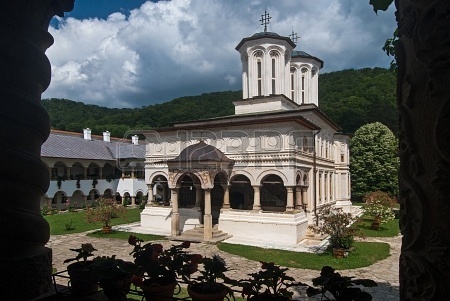Stephen Morris's Blog, page 54
July 11, 2013
July 12, 1801: Vampires home free after two strikes

The Monastery of Horezu, a UNESCO World Heritage site in Wallachia, Romania
Wallachia, the region of southern Romania and which borders the more famous region of Transylvannia to the north, was an independent principality until 1859, when it united with Moldavia to form the basis of the modern state of Romania, with Transylvania joining 59 years later (1918) to form the new Kingdom of Romania which was first established 1881.
In 1801, before its unification with Moldavia, there was still a fervent and widespread belief in vampires among the farmers and rural peasants though modern science was beginning to dispel vampiric beliefs among the aristocracy. One of the more common ways of dispatching a vampire in the countryside was to exhume the body and decapitate the corpse. If that did not work, the body was exhumed again and a wooden stake driven through it or it might be turned to face down. If all else failed, a third exhumation could lead the to burning of the corpse (which was a difficult undertaking and therefore the last resort of the vampire dispatchers).
It was the continued exhumation of corpses which came to the attention of the Wallachian authorities. On July 1, 1801 there was a proclamation made that in Wallachian territory a corpse could not be exhumed more than TWICE if it was suspected of being a vampire!
July 8, 2013
Summer Lightning

Thunderstorms and lightning strikes are most likely in spring and summer storms.
The only law against magic made by Constantine in 321 AD exempts magical “steps taken in country districts, that there may be no apprehension of (heavy) rain when the grapes are ripe, or that they may not be dashed to pieces by the force of hailstorms.” (You can read more in Witchcraft and Magic in Europe: Ancient Greece and Rome.)
There are references to weather magic as early as ancient Greece, as in this quote by Empedocles:
And you’ll stop the force of the tireless winds that chase over the earth
And destroy the fields with their gusts and blasts;
But then again, if you so wish, you’ll stir up winds as requital.
Out of a black rainstorm you’ll create a timely drought
For men, and out of a summer drought you’ll create
Tree-nurturing floods that will stream through the ether
And you will fetch back from Hades the life-force of a man who has died.
(see more in Ancient Philosophy, Mystery, and Magic: Empedocles and Pythagorean Tradition, with thanks to http://www.otherworld-apothecary.com)
In the Jewish practice, a blessing “…He who does acts of creation” is to be recited, upon sighting lightning. The Talmud refers to the Hebrew word for the sky, (“Shamaim“) – as built from fire and water (“Esh Umaim“), since the sky is the source of the inexplicable mixture of “fire” and water that come together, during rainstorms. This is mentioned in various prayers and discussed in writings of Kabbalah.
The Norse rune known as “Thorn” is also associated with lightning for a variety of reasons. It is the rune of cutting, sharpness, and pain, as well as brute strength, the destructive power of chaos and ruin. It also stands in for death and regeneration, transformation and the breaking down barriers. It can be used to bring on the energies of the berserker and energies this wild should only be used in war or attack. It can be used in magic to raise and guide thunderstorms and direct lightning. In many German fairy tales such as “Sleeping Beauty” the prick of a thorn, pin or spindle casts a spell upon the victim. The bloodstone has been used with this rune in the raising of thunderstorms.
July 1, 2013
Cancer, the Crab

This depiction of the constellation Cancer (the Crab) is taken from the Celestial Atlas by Alexander Jamieson – 1822.
Although modern astrologers identify the sign of Cancer as a crab, it has been represented as various types of creatures, usually those living in the water, and always those with an exoskeleton.
The identification of Cancer as a crab is rooted in the Twelve Labors of Hercules tale. Hercules battled the multi-headed Lernaean Hydra and Hera had sent a large crab to distract Hercules and put him at a disadvantage during the battle. But Hercules quickly dispatched the creature by kicking it with such force that it was propelled into the sky. Other accounts say the crab grabbed onto Hercules’ toe with its claws, but Hercules simply crushed the crab underfoot. Hera, grateful for the creature’s heroic effort, gave it a place in the sky. (Some scholars have suggested that the crab was a late addition to the myth of Hercules in order to make the Twelve Labors correspond to the twelve signs of the Zodiac.)
In the Egyptian records of about 2000 BC, the Cancer sign was described as Scarabaeus (Scarab), the sacred emblem of immortality. In Babylonia the constellation was known by a name which can refer to both a crab and a snapping turtle. There also appears to be a strong connection between the Babylonian constellation and ideas of death and a passage to the underworld, which may be the origin of these ideas in much later Greek myths associated with Hercules and the Hydra. In the 12th century, an illustrated astronomical manuscript shows it as a water beetle. Albumasar writes of this sign in the work published in 1489 as a large crayfish. Jakob Bartsch and Stanislaus Lubienitzki, in the 17th century, described it as a lobster.
Those born during the Cancer period (June 22–July 22) are said to be emotional and intuitive but shrewd.
June 26, 2013
Midsummer

A bonfire for Midsummer in Mäntsälä, Finland.
The summer solstice, more commonly known as Midsummer, marked the longest day of the year and the zenith of magical power often called “white magic.” Magic worked on Midsummer was most often concerned with life and fertility. Jumping through the Midsummer bonfire was a way to attract fertility, good luck, and prosperity to both the jumper and the surrounding fields. The bonfires of Midsummer are traditionally kindled from the friction of two sacred woods, fir and oak. Nine different types of herbs are thrown upon the Midsummer fire: mistletoe, vervain, St. John’s Wort, heartsease, lavender, and a choice of four others chosen from herbs typical of this season such as yarrow. Folks would feast, dance and jump the fire for luck and fertility. The herds were driven through the embers in days long ago to purge disease and illness from them. When the fires had burned down, folks would carry ashes back to their homes to sprinkle on fields, the four corners, and lay embers on the hearth. The ashes bring powers of protection, health and luck.
Water is the other important aspect of Midsummer. In times past folks swam in waters that flowed towards the rising sun as it climbed in Midsummer morning sky. Bathing in springs and rivers on Midsummer brings healing, cleansing and protection. The dew of Midsummer is said to bestow health to whomever drinks of it. Especially powerful is fetching running water of Midsummer morn and mixing it with ashes from the bonfire, sprinkling it around the house, yard and on oneself bestows protection and luck. Iceland combined the beliefs about bathing and dew into one practice: Icelandic folklore says that if you bathe naked in the morning dew on the morning of June 24, you will keep aging at bay for longer.) Midsummer Eve, the night before the solstice, is the evening of herbs. The herbs and flowers gathered this night are considered exceptionally potent. St John’s Wort, burdock, thorn, and nettle , should be harvested on Midsummer Eve and hung on doors or windows and placed around the home for protection. Royal Fern seeds which are gathered at midsummer are said to make the possessor invisible. They who find Royal Fern blossoms on Midsummer’s eve become wise, lucky, and wealthy. Women wear braided circlets of clover and flowers, while men wear chaplets of oak leaves and flowers around their heads. In times past, livestock were also decorated with garlands made of flowers, foliage, and oak leaves.
June 23, 2013
St. John The Baptist @ Slavic Midsummer

Girls in Belarus set wreaths and candles afloat as part of Kupala Night celebrations.
Ivan Kupala was the old Russian name for John the Baptist, whose Christian feast coincides with the ancient celebration of Midsummer. Up to the present day, the Russian Midsummer Night (or Ivan’s Day) is known as one of the most expressive Russian folk and pagan holidays.
Many rites of this holiday are connected with water, fertility and purification. The girls, for example, would float their flower garlands and candles on the water of rivers and tell their fortunes from their movement. Boys and girls alike would jump over the flames of bonfires. Nude bathing is likewise practiced. A prominent Ivan Kupala night scene involving nude swimming is featured in Andrei Tarkovsky’s film Andrei Rublev.
There is an ancient Kupala belief, that the eve of Ivan Kupala is the only time of the year when ferns bloom. Prosperity, luck, discernment and power would befall on whoever finds a fern flower. Therefore, on that night village folks would roam through the forests in search of magical herbs and especially the elusive fern flower. In Gogol’s story The Eve of Ivan Kupala, a young man finds the fabulous fern-flower but is cursed by it. Gogol’s tale may have been the stimulus for Modest Mussorgsky to compose his tone poem Night on Bald Mountain.
Traditionally, unmarried women, signified by their garlands on their hair, would be the first to enter the forests. They are followed by young men. Therefore, consequent to the quest in finding herbs and the fern flower may be the blooming of relationships between pairs of men and women within the forest.
In Serbia, Saint John (Sveti Jovan or also called Superman) is known by the name Igritelj (dancer) because it is thought the sun is dancing on this day. Girls will watch the sunrise through a wreath, to become as red (i.e. beautiful, as “red” and “beautiful” share the same root in Slavic languages) as the sun. At dusk, Ivanjske vatre (St. John Fires) are lit, and dancing and singing and drinking take place.
June 18, 2013
St. John’s Wort

St. John’s Wort can be used to detect another person’s use of magic; in times past, it was held to the lips of accused witches to force them into confessing.
St. John’s Wort (“wort” is Middle English for “plant,” from the Old English wyrt) is one of the most powerful and commonly used of the magical herbs. Considered a “masculine” herb and associated with the sun and fire, it is used to conjure health and protection as well as strength, love, and happiness. It is also used for divination.
With the advent of Christianity, it was associated with St. John the Baptist, and was said to start blooming on his birthday, June 24 (i.e. Midsummer). On the day of his beheading (August 29), the plant was believed to bleed red oil from its leaf glands. It is to this day believed to be at it’s most potent when harvested at Midsummer, likely due to the timing of the birthday celebration of St. John the Baptist. The genus name Hypericaceae means “above an icon” in Greek, and sprigs of the plant were used on images and statuary by the ancients to drive off evil spirits.
In modern magic, St. John’s Wort is believed to be of benefit when carried on the person for courage, protection, detecting other magicians, and strengthening the will when confronted with bad situations. The leaves made into a necklace are believed to ward off sickness and tension, and to enhance endurance and will when doing battle.
For protection from lightning, fires, strong storms, and evil spirits place sprigs of St. John’s Wort in a jar and place the jar on a windowsill. Similarly, hanging bunches of the plant over every window of the house is said to protect from evil spirits and evil or demonic witchcraft. Burning St. John’s Wort as incense or in the fireplace thought to protect the home and repel unfriendly spirits, and burning is common in exorcism rituals.
Placing St. John’s Wort under the pillow of a single woman at night is said to induce dreams of her future husband.
One old Welsh custom for Midsummer was to hang a sprig of St. John’s Wort on a rafter for each family member for the night. The degree of wilting of each sprig the next morning was said to foretell how soon each individual would die, thus giving clues on the state of the health of the individual.
June 12, 2013
Pearl, the birthstone of June
In Greek mythology, pearls were tears of joy that Aphrodite, the Goddess of Love, shed when she was born from sea froth. Persian mythology gives us the same belief that pearls are hardened tears. Ancient Chinese mythology gives a grimmer origin to pearls: they believed they came from inside the brains of dragons.
To Muslims the pearl is one of the rewards to be found in the afterlife. It symbolizes absolute perfection in Islamic tradition. In some early Arabian legends pearls are hardened moon drops, and the oysters that give birth to the pearls were lured to the sea by the moon itself.
It is said that to give a pearl to a child born in June will ensure they have a long life.
Wearing pearls is sometimes said to cure madness, and also help to treat jaundice, and snake and insect bites. Pearls are also thought to cure depression in women – maybe because receiving pearls is sure to make most women happy. But be careful — not only are pearls said to have aphrodisiac properties, but placing a pearl under one’s pillow and sleeping on it may cause couples to conceive.
Pearls should only be purchased for someone else because wearing pearls you purchased yourself is considered unwise and unlucky. But even if they are a gift, a bride should never wear pearls as a woman will shed a tear for every pearl that she wears on her wedding day.
Furthermore, be warned, gentlemen: a pearl given to a woman by her lover or husband will loose its luster if the man is unfaithful!
June 10, 2013
Rose, the flower of June
Roses, the flower of June, are reputed to have many and varied magical uses. Modern uses associate roses most often with love but older uses include just as many practices that involve roses and death.
Falling rose petals may be an omen of death. One superstition like that is that if rose petals fall off roses a person is holding then that person will pass away soon. In more general terms, it is a sign of misfortune if a rose blooms in the autumn.
Romans decorated their tombs with roses. Roses can be planted near graves to protect the dead from evil. (Red roses were planted to mark the graves of lovers and white roses to mark the graves of virgins.)
If a young woman has more than one lover she can determine the one to marry by writing the men’s names on rose leaves and then throwing them into the wind. The name on the last leaf to touch the ground is the one she will marry. Or a girl has no prospective lovers, she can carefully wrap a rose away in a piece of clean white paper on Midsummer Eve and keep it until Christmas Day. If the rose is still intact, she has to wear it in her buttonhole. The first man who admires the rose will become her husband.
June 3, 2013
Who’s Conjuring Svetovit NOW? Prague Floods 2013

People with belongings they can carry hurry to escape the rising flood in Prague a day ago.
Floods are rushing into Prague over the last few days, causing many to fear a repeat of the August 2002 flood. All of Central Europe is experiencing the rising waters, with Germany and Austria also badly flooded.
Read details on BBC here.
Read details on Bloomberg news here.
See the Reuters report here.
See video reports here.
May 30, 2013
Gemini

Statue of the twins Castor and Pollux, now in the Parc de Versailles.
In Greek and Roman mythology, Castor and Pollux were twin brothers, together known as the Dioscuri. Their mother was Leda, but Castor was the mortal son of Tyndareus, the king of Sparta, and Pollux the divine son of Zeus, who seduced or raped Leda in the guise of a swan.Though accounts of their birth are varied, they are sometimes said to have been born from an egg, along with their twin sisters Helen of Troy and Clytemnestra.
In Latin the twins are also known as the “Gemini” or “Castores.” When Castor was killed, Pollux asked Zeus to let him share his own immortality with his twin to keep them together, and they were transformed into the constellation Gemini. The pair was regarded as the patrons of sailors, to whom they appeared as St. Elmo’s Fire, and were also associated with horsemanship.
Even after the rise of Christianity, the Dioskouroi continued to be venerated. The fifth-century pope Gelasius I attested to the presence of a “cult of Castores” that the people did not want to abandon. In some instances, the twins appear to have simply been absorbed into a Christian framework; thus fourth-century AD pottery and carvings from North Africa depict the Dioskouroi alongside the Twelve Apostles, the Raising of Lazarus or with Saint Peter. The church took an ambivalent attitude, rejecting the immortality of the Dioskouroi but seeking to replace them with equivalent Christian pairs. Saints Peter and Paul were thus adopted in place of the Dioskouroi as patrons of travelers, and Saints Cosmas and Damian took over their function as healers.
Those born May 21–June 21 are considered to be under the patronage of the Twins and are intellectually inclined, forever in search of information. The more information a Gemini collects, the better. Sharing that information later on with those they love is also a lot of fun, for Geminis are supremely interested in developing their relationships. Dalliances with these folks are always enjoyable, since Geminis are bright, quick-witted and the proverbial “life of the party.” Even though their intellectual minds can rationalize forever and a day, Geminis also have a surplus of imagination waiting to be tapped.







